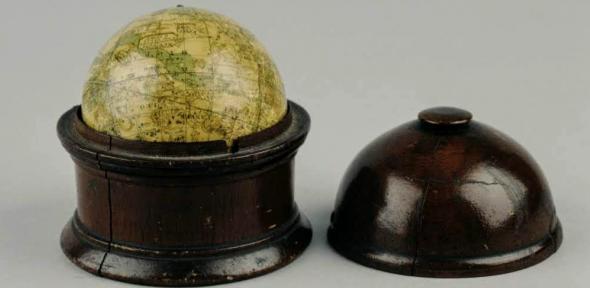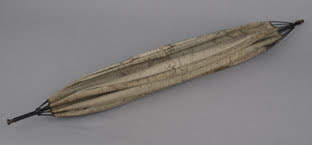Globes retained their decorative function in the 17th century, and some innovative designs were produced that promoted the gentlemanly use of globes as accessories or furniture items. Pocket globes were first produced in England by Joseph Moxon (1627-1691) in 1673, and gentlemen might well have used these miniature instruments as status symbols. Moxon also collaborated with Roger Palmer to make the 'English Globe' in 1679 (Image 1), which was best used in the garden. Indeed, the fact that the 'English Globe' could not be rotated on its stand meant that it could only be used for latitudes matching that of the south of England and would have been useless on sea voyages. Pocket globes and instruments such as the 'English Globe' meant that makers could promote globes among new audiences.
Read more: pocket globes
Read more: the "English globe"
While makers innovated some designs to attract new users, they kept abreast of cartographic developments and continued to produce globes that recorded the most recent discoveries. Robert Morden, who collaborated with William Berry and Philip Lea to produce a globe sometime between 1683 and 1690, declared in his Geography rectified, or, A description of the world (1693) that:
"[I]t is a boldness justifiable by truth, to affirm that all former Geographies diligently compared with the more accurate Observations and Discoveries of late years are greatly defective, and strangely erroneous."
While Morden was not advocating the use of the globe in practical navigation, he certainly felt that accuracy was important. If a globe recorded the latest discoveries in the way that Morden described, possession of the globe would indicate the owner's awareness of the most cutting edge geographical findings.
Read more: the globe made by Robert Morden
The 18th century
The 18th century is sometimes seen as a second 'age of exploration', following the initial voyages of discovery in the late 15th and 16th centuries. When four Royal Navy ships were wrecked off the Scilly Isles in 1707 on account of navigational errors, the British Government established the Commissioners for the Discovery of the Longitude at Sea (also known as the Board of Longitude), which offered large monetary prizes to anyone who could devise a method for accurately finding longitude. This motivated a more practical approach to sailing in the 18th century.
Globes sat awkwardly among air pumps and microscopes, the established apparatus of the rationalists. Many judged that globes could only be used to record, but not to make, discoveries. For example, Joseph Priestley (1733-1804), a Fellow of the Royal Society, felt that globes were only explanatory devices, which "like books, have no uses more extensive than the view of human ingenuity".
In spite of the cynicism that some felt towards globes, they proved useful for recording the new discoveries made in the 18th century, including many of the Pacific islands and New Caledonia. Existing territories were also updated in line with continuing exploratory ventures. For instance, California, which had been depicted as an island since the early 17th century, was mapped as a peninsula with increasing frequency throughout the 18th century.




